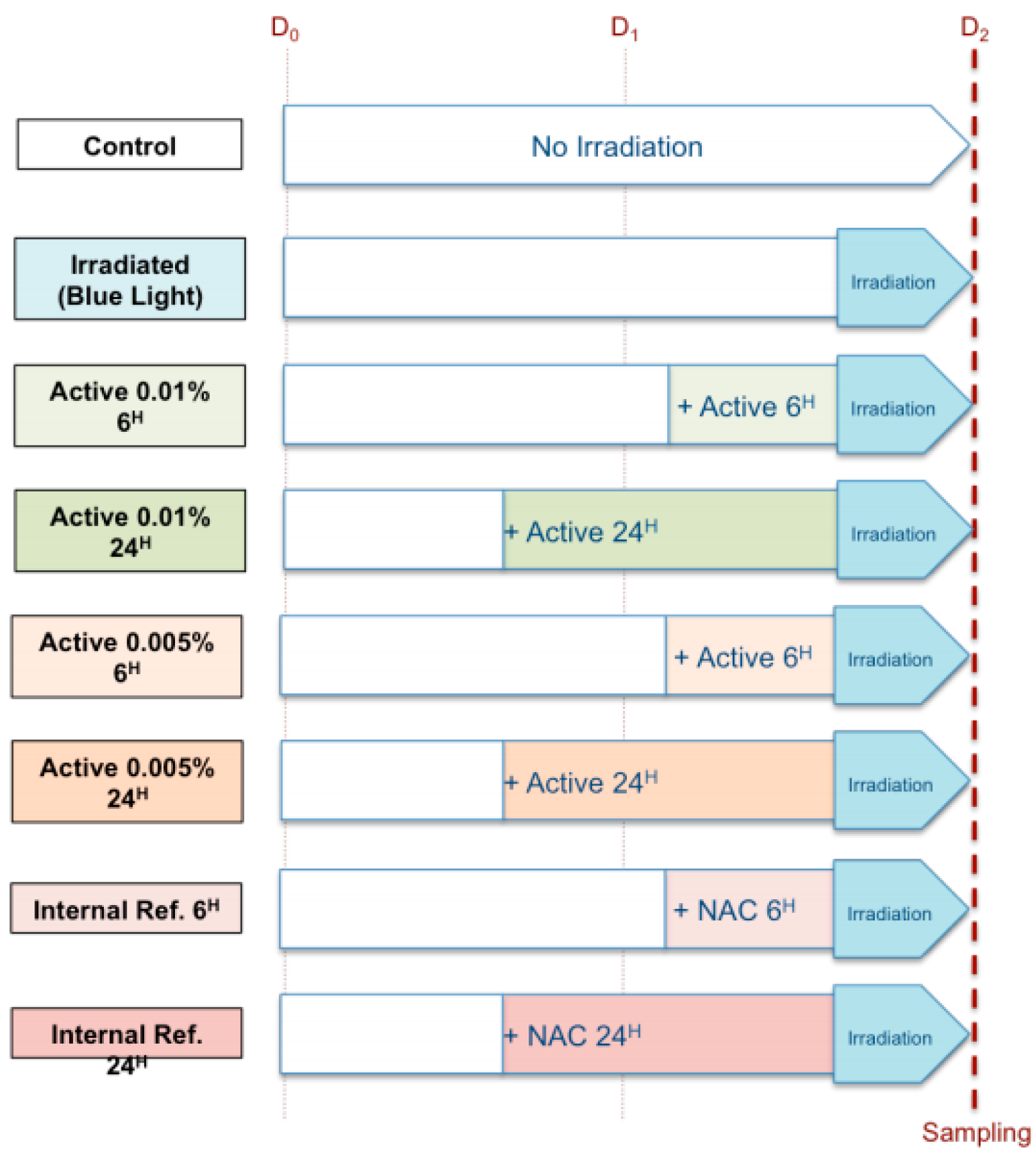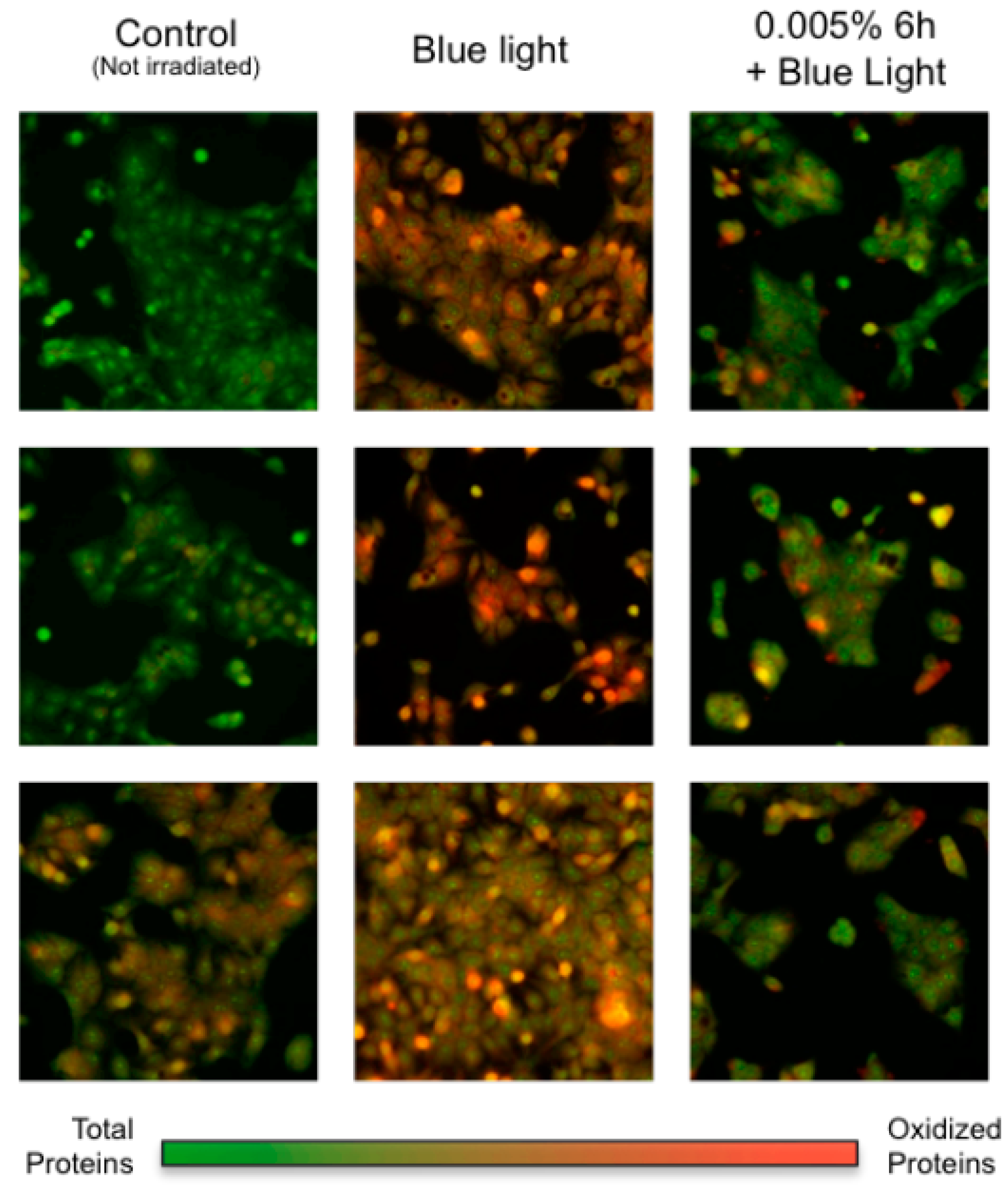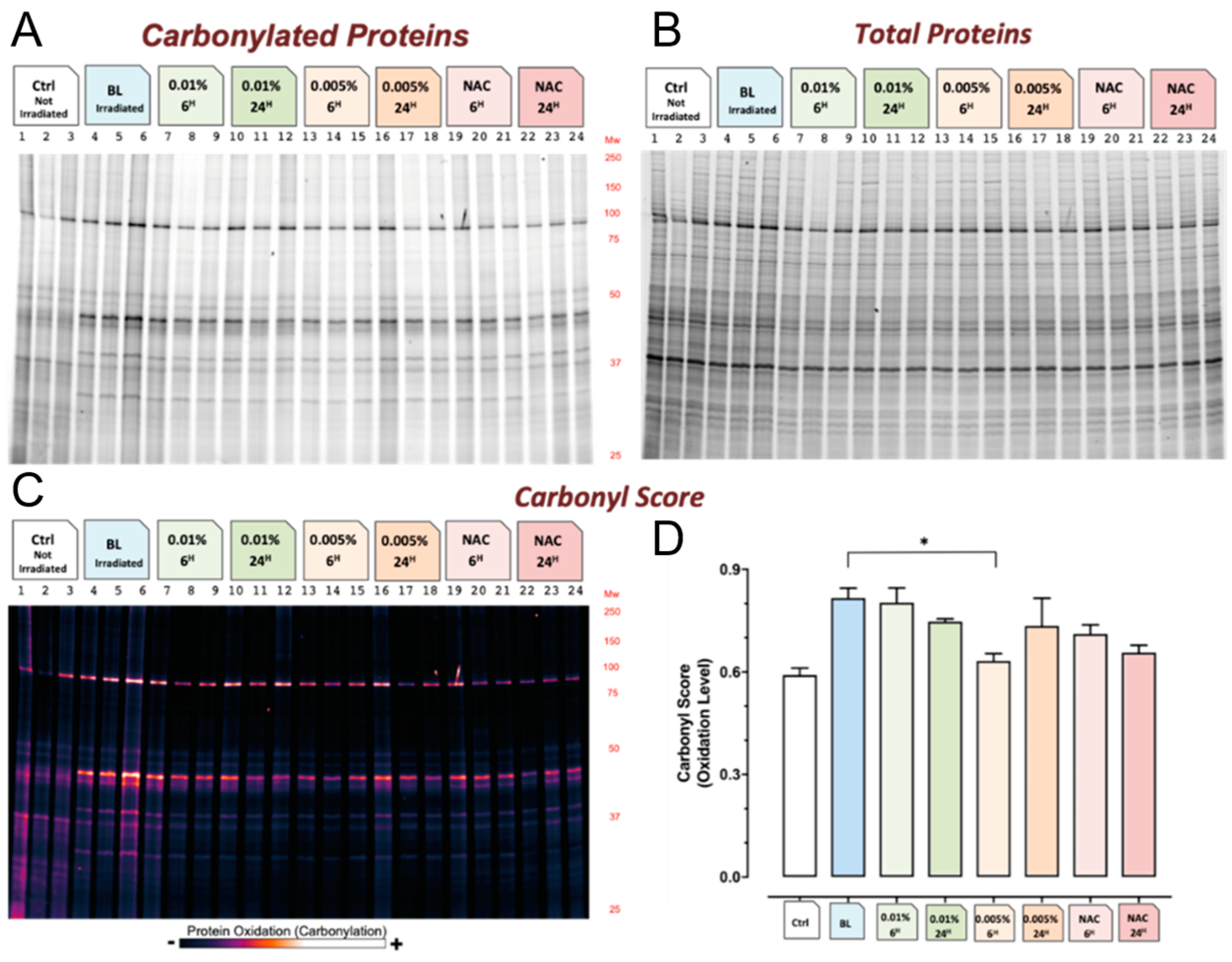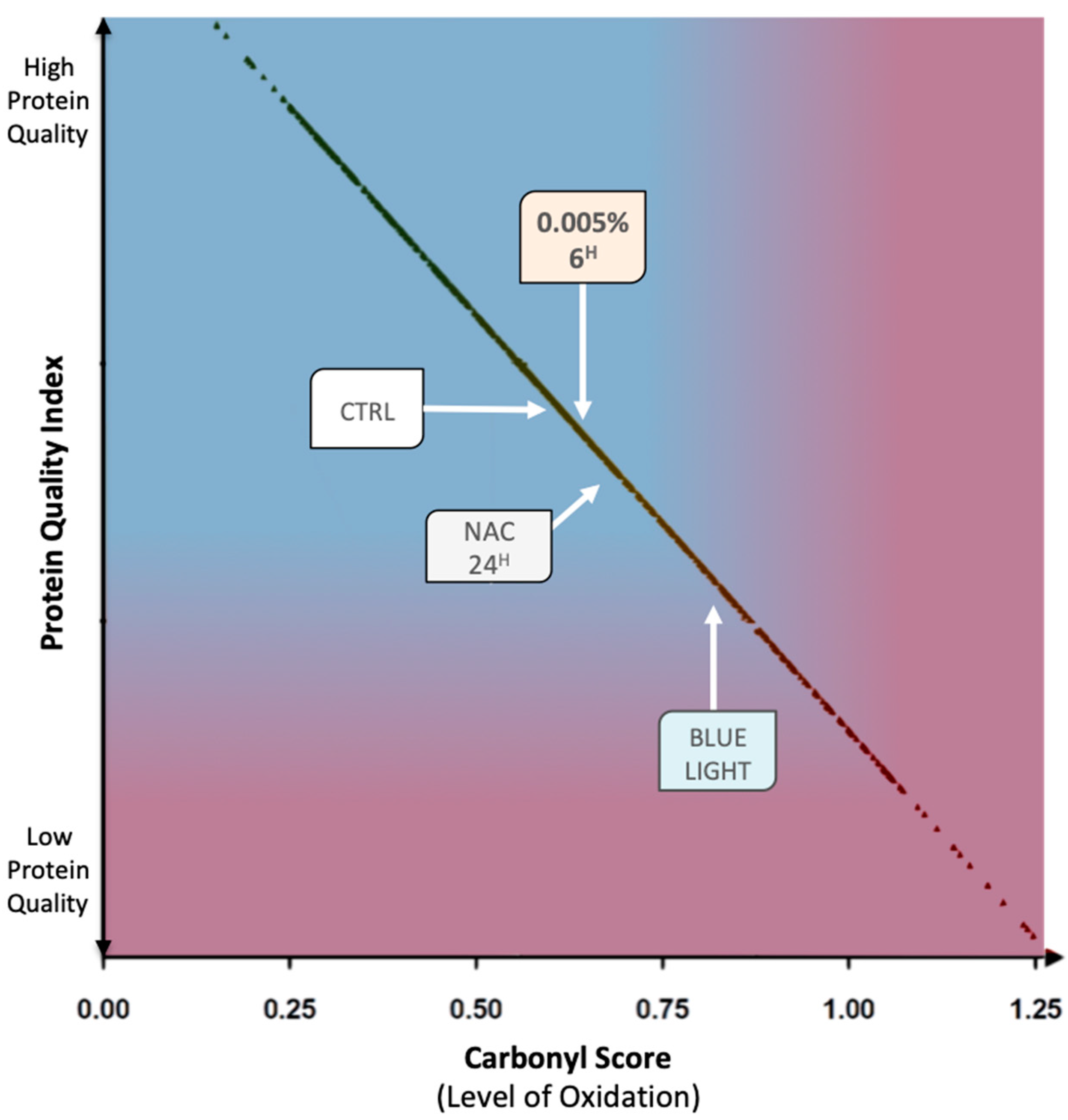Vitachelox: Protection of the Skin Against Blue Light-Induced Protein Carbonylation
Abstract
1. Introduction
2. Material and Methods
2.1. Experimental Design
2.2. Protein Carbonylation Analysis
3. Results
4. Discussion
5. Conclusions
Author Contributions
Funding
Acknowledgments
Conflicts of Interest
References
- Wanger, F.A.; Carels, C.E.; Lundvig, D.M. Targeting the redox balance in inflammatory skin conditions. Int. J. Mol. Sci. 2013, 14, 9126–9167. [Google Scholar]
- Godic, A.; Polisak, B.; Adamic, M.; Dahmane, R. The role of antioxidants in skin cancer prevention and treatment. Oxid. Med. Cell. Longev. 2014, 2014, 860479. [Google Scholar] [CrossRef] [PubMed]
- Chevion, M.; Berenshtein, E.; Stadtman, E.R. Human studies related to protein oxidation: protein carbonyl content as a marker of damage. Free Radic. Res. 2000, 33, S99–S108. [Google Scholar] [PubMed]
- Kobayashi, Y.; Iwai, I.; Akutsu, N.; Hirao, T. Increased carbonyl protein levels in the stratum corneum of the face during winter. Int. J. Cosmet. Sci. 2008, 30, 35–40. [Google Scholar] [CrossRef] [PubMed]
- Mizutani, T.; Sumida, H.; Sagawa, Y.; Okano, Y.; Masaki, H. Carbonylated proteins exposed to UVA and to blue light generate reactive oxygen species through a type I photosensitizing reaction. J. Dermatol. Sci. 2016, 84, 314–321. [Google Scholar] [CrossRef] [PubMed]
- Negre-Salvayre, A.; Coatrieux, C.; Ingueneau, C.; Salvayre, R. Advanced lipid peroxidation end products in oxidative damage to proteins. Potential role in diseases and therapeutic prospects for the inhibitors. Br. J. Pharmacol. 2008, 153, 6–20. [Google Scholar] [CrossRef] [PubMed]
- Iwai, I.; Shimadzu, K.; Kobayashi, Y.; Hirao, T.; Etou, T. Increased carbonyl protein level in the stratum corneum of inflammatory skin disorders: A non-invasive approach. J. Dermatol. 2010, 37, 693–698. [Google Scholar] [CrossRef] [PubMed]
- Podhaisky, H.P.; Riemschneider, S.; Wohlrab, W. UV light and oxidative damage of the skin. Pharmazie 2002, 57, 30–33. [Google Scholar]
- Nakashima, Y.; Ohta, S.; Wolf, A.M. Blue light-induced oxidative stress in live skin. Free Radic. Biol. Med. 2017, 108, 300–310. [Google Scholar] [CrossRef] [PubMed]
- Nichols, J.A.; Katiyar, S.K. Skin photoprotection by natural polyphenols: anti-inflammatory, antioxidant and DNA repair mechanisms. Arch. Dermatol. Res. 2010, 302, 71–83. [Google Scholar] [CrossRef] [PubMed]
- Giacomelli, L.; Togni, S.; Meneghin, M.; Roberto, E.; Giada, M. In vivo validation of the multi-component powder (Vitachelox®) against the deposition of polluting ions. Clin. Cosmet. Investig. Dermatol. 2018, 11, 109–113. [Google Scholar] [CrossRef] [PubMed]
- Vayalil, P.K.; Mittal, A.; Hara, Y.; Elmets, C.A.; Katiyar, S.K. Green tea polyphenols prevent ultraviolet light-induced oxidative damage and matrix metalloproteinases expression in mouse skin. J. Investig. Dermatol. 2004, 122, 1480–1487. [Google Scholar] [CrossRef] [PubMed]
- Pires, F.; Geraldo, V.P.N.; Antunes, A.; Marletta, A.; Oliveira Jr, O.N.; Raposo, M. Effect of blue light irradiation on the stability of phospholipid molecules in the presence of epigallocatechin-3-gallate. Colloids Surf. B Biointerfaces 2019, 177, 50–57. [Google Scholar] [CrossRef] [PubMed]
- Andrensek, S.; Simonovska, B.; Vovk, I.; Fyhrquist, P.; Vuorela, H.; Vuorela, P. Antimicrobial and antioxidative enrichment of oak (Quercus robur) bark by rotation planar extraction using ExtraChrom®. Int. J. Food Microbiol. 2004, 92, 181–187. [Google Scholar] [CrossRef] [PubMed]
- Baraibar, M.A.; Ladouce, R.; Friguet, B. Proteomic quantification and identification of carbonylated proteins upon oxidative stress and during cellular aging. J. Proteom. 2013, 92, 63–70. [Google Scholar] [CrossRef]
- Rasband, W.S. Image JUS National Institutes of Health, Bethesda, MD, USA, 1997–2018. Available online: http://imagej.nih.gov/ij/ (accessed on 7 August 2019).
- Bradford, M. A rapid and sensitive method for the quantitation of microgram quantities of protein utilizing the principle of protein-dye binding. Anal. Biochem. 1976, 72, 248. [Google Scholar] [CrossRef]
- Maramaldi, G.; Corti, A.; Togni, S.; Meneghin, M.; Nobile, V.; Giacomelli, L.; Katinka, J. Antioxidant action and microflora modulation of Vitachelox® in subjects with acne-prone skin. Esper. Dermatol. 2019, 21, 16–21. [Google Scholar]





| Parameter | Value |
|---|---|
| Wavelength | 460 nm |
| Source | LED |
| Irradiance | 53 mW/cm2 |
| Dose | 35 J/cm2 |
| Irradiation time | 11 min |
© 2019 by the authors. Licensee MDPI, Basel, Switzerland. This article is an open access article distributed under the terms and conditions of the Creative Commons Attribution (CC BY) license (http://creativecommons.org/licenses/by/4.0/).
Share and Cite
Togni, S.; Maramaldi, G.; Cavagnino, A.; Corti, A.; Giacomelli, L. Vitachelox: Protection of the Skin Against Blue Light-Induced Protein Carbonylation. Cosmetics 2019, 6, 49. https://doi.org/10.3390/cosmetics6030049
Togni S, Maramaldi G, Cavagnino A, Corti A, Giacomelli L. Vitachelox: Protection of the Skin Against Blue Light-Induced Protein Carbonylation. Cosmetics. 2019; 6(3):49. https://doi.org/10.3390/cosmetics6030049
Chicago/Turabian StyleTogni, Stefano, Giada Maramaldi, Andrea Cavagnino, Ambra Corti, and Luca Giacomelli. 2019. "Vitachelox: Protection of the Skin Against Blue Light-Induced Protein Carbonylation" Cosmetics 6, no. 3: 49. https://doi.org/10.3390/cosmetics6030049
APA StyleTogni, S., Maramaldi, G., Cavagnino, A., Corti, A., & Giacomelli, L. (2019). Vitachelox: Protection of the Skin Against Blue Light-Induced Protein Carbonylation. Cosmetics, 6(3), 49. https://doi.org/10.3390/cosmetics6030049






